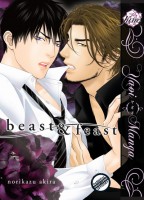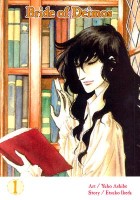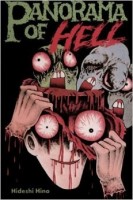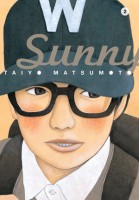My News and Reviews
With all of the various review project that I recently have had going on, it’s been a while since there’s only been two posts at Experiments in Manga for any given week. (Not counting the My Week in Manga feature.) Last week I posted a review of Chōhei Kambayashi’s science fiction novel Yukikaze. Although interesting from the start, it did take me a few chapters to really get into the book, but ultimately I was very impressed with the depth of Kambayashi’s ideas. The sequel Good Luck, Yukikaze has also been translated and released in English. I’ll be making a point of reading it, as well. My other post last week was a part of the Discovering Manga feature which explores some of the ways that I learn about and learn more about manga and the manga industry. This time around I talked about the site Organization Anti-Social Geniuses which has some great manga-related content–not just reviews, but articles and interviews, too. If you’re not already familiar with OASG, it’s definitely worth checking out.
As for other things worth checking out online: Justin Stroman’s most recent guest post at Manga Bookshelf focuses on manga adapters and the history of manga adaptation. Vertical is hinting at a new license. (A huge volume of 1980s manga, possibly in hardcover? Yes, please.) Manjiorin of Manga Connection has started her Swan review project. I recently finished reading all of Swan that was published in English. I absolutely loved the series, so am looking forward to reading her reviews. A Bento Books newsletter is now available for those interested in staying on top of Bento Books and its releases. The Kodansha Comics tumblr weighs in on piracy from a publisher’s perspective. And finally, Ryan Holmberg takes a look at 1930s shoujo manga with his article Matsumoto Katsuji and the American Roots of Kawaii.
Quick Takes
 Beast & Feast by Norikazu Akira. After a somewhat dubious first chapter, Beast & Feast ends up being a rather cute and sweet boys’ love manga, although it does seem a little odd to describe it using those words. Considering the seriousness of the yakuza storyline and the violence (mostly implied rather than seen), the manga can actually be surprisingly lighthearted. This is mostly due to the characters. Despite their differences, and despite the fact that Hyodo is a yakuza and Kazuha is a police detective, the two of them ultimately make a great couple and they care about each other tremendously. There’s also a fair amount of explicit sex. Hyodo’s sexual appetite is insatiable, making Beast & Feast a very apt title for the manga. While I wasn’t blown away by Beast & Feast, it was solidly entertaining in addition to having attractive artwork. I enjoyed the manga and its characters. So much so that I plan on picking up Honey Darling, the only other manga by Akira currently available in English. (Actually, now that I think about it, she also collaborated on Clan of the Nakagamis.)
Beast & Feast by Norikazu Akira. After a somewhat dubious first chapter, Beast & Feast ends up being a rather cute and sweet boys’ love manga, although it does seem a little odd to describe it using those words. Considering the seriousness of the yakuza storyline and the violence (mostly implied rather than seen), the manga can actually be surprisingly lighthearted. This is mostly due to the characters. Despite their differences, and despite the fact that Hyodo is a yakuza and Kazuha is a police detective, the two of them ultimately make a great couple and they care about each other tremendously. There’s also a fair amount of explicit sex. Hyodo’s sexual appetite is insatiable, making Beast & Feast a very apt title for the manga. While I wasn’t blown away by Beast & Feast, it was solidly entertaining in addition to having attractive artwork. I enjoyed the manga and its characters. So much so that I plan on picking up Honey Darling, the only other manga by Akira currently available in English. (Actually, now that I think about it, she also collaborated on Clan of the Nakagamis.)
 Bride of Deimos, Volumes 1-7 written by Etsuko Ikeda, illustrated by Yuho Ashibe. There is something about shoujo horror that I find irresistible; maybe it’s just that so much of it seems to have close ties to Gothic literature and Romanticism and emphasizes the emotional and psychological aspects of the story. Bride of Deimos is an interesting example of this type of shoujo horror. It’s from the 1970s and so it also has that fabulous classic shoujo style, too. Only seven of the seventeen volumes were ever released in English. However, the manga tends to be mostly episodic, so it’s not as though the story feels terribly incomplete. I do wish more had been translated though; I ended up really enjoying the series. The framing story for Bride of Deimos focuses on Minako, a young woman whom the androgynously beautiful devil Deimos is determined to make his bride. Many of the individual tales in some way involve love and generally end very badly for those involved. Bride of Deimos somewhat strangely incorporates both Japanese and Greek mythology as well other elements of traditional Western horror and the supernatural.
Bride of Deimos, Volumes 1-7 written by Etsuko Ikeda, illustrated by Yuho Ashibe. There is something about shoujo horror that I find irresistible; maybe it’s just that so much of it seems to have close ties to Gothic literature and Romanticism and emphasizes the emotional and psychological aspects of the story. Bride of Deimos is an interesting example of this type of shoujo horror. It’s from the 1970s and so it also has that fabulous classic shoujo style, too. Only seven of the seventeen volumes were ever released in English. However, the manga tends to be mostly episodic, so it’s not as though the story feels terribly incomplete. I do wish more had been translated though; I ended up really enjoying the series. The framing story for Bride of Deimos focuses on Minako, a young woman whom the androgynously beautiful devil Deimos is determined to make his bride. Many of the individual tales in some way involve love and generally end very badly for those involved. Bride of Deimos somewhat strangely incorporates both Japanese and Greek mythology as well other elements of traditional Western horror and the supernatural.
 Panorama of Hell by Hideshi Hino. And then there’s Panorama of Hell, a horror manga of a completely different sort from 1982. As can probably be determined from the cover alone, Panorama of Hell is extremely gruesome, bloody, violent, and visceral. Panorama of Hell is legitimately terrifying and frightening, and probably one of the best horror manga that I have read. But because it is so graphic and disturbing, and because the humor is so exceptionally dark, Panorama of Hell is definitely not something that I would recommend to just anyone. It takes a reader with a strong heart and stomach to really appreciate the manga. Panorama of Hell is the story of an unnamed painter who has an obsession with blood which he uses in the creation of his artwork. The manga explores his paintings before turning to his family, his past, and all of the abuse and insanity which has had a tremendous influence on him. Hino mixes surreal imagery with historic events in Panorama of Hell. The results are hellish, driving home just how terrible reality can be. Some of Panorama of Hell is actually based on Hino’s life, which in itself is terrifying.
Panorama of Hell by Hideshi Hino. And then there’s Panorama of Hell, a horror manga of a completely different sort from 1982. As can probably be determined from the cover alone, Panorama of Hell is extremely gruesome, bloody, violent, and visceral. Panorama of Hell is legitimately terrifying and frightening, and probably one of the best horror manga that I have read. But because it is so graphic and disturbing, and because the humor is so exceptionally dark, Panorama of Hell is definitely not something that I would recommend to just anyone. It takes a reader with a strong heart and stomach to really appreciate the manga. Panorama of Hell is the story of an unnamed painter who has an obsession with blood which he uses in the creation of his artwork. The manga explores his paintings before turning to his family, his past, and all of the abuse and insanity which has had a tremendous influence on him. Hino mixes surreal imagery with historic events in Panorama of Hell. The results are hellish, driving home just how terrible reality can be. Some of Panorama of Hell is actually based on Hino’s life, which in itself is terrifying.
 Sunny, Volumes 2-3 by Taiyo Matsumoto. Sunny is another manga that draws inspiration from the creator’s life. Set in Japan in the 1970s, Sunny can be almost overwhelmingly melancholic. Although there are heartwarming moments there are just as many scenes that are absolutely heartbreaking. Sunny follows the lives of the children at the Star Kids Home. Some are orphans, some have been completely abandoned by their parents, and some have only been temporarily separated from their families. The story also follows the adults in their lives, both those who are positive influences on the children and those who have caused them harm. The people at Star Kids Home, the children and the adults, form an odd sort of family with all of the benefits and disadvantages that that entails. Out of all of the manga by Matsumoto that has so far been released in English, Sunny is the most realistic and therefore probably the most readily accessible for a casual reader. It lacks much of the surrealism present in his other works. Instead Sunny relies even more heavily on the complexities of the characters and their relationships with one another.
Sunny, Volumes 2-3 by Taiyo Matsumoto. Sunny is another manga that draws inspiration from the creator’s life. Set in Japan in the 1970s, Sunny can be almost overwhelmingly melancholic. Although there are heartwarming moments there are just as many scenes that are absolutely heartbreaking. Sunny follows the lives of the children at the Star Kids Home. Some are orphans, some have been completely abandoned by their parents, and some have only been temporarily separated from their families. The story also follows the adults in their lives, both those who are positive influences on the children and those who have caused them harm. The people at Star Kids Home, the children and the adults, form an odd sort of family with all of the benefits and disadvantages that that entails. Out of all of the manga by Matsumoto that has so far been released in English, Sunny is the most realistic and therefore probably the most readily accessible for a casual reader. It lacks much of the surrealism present in his other works. Instead Sunny relies even more heavily on the complexities of the characters and their relationships with one another.
 MICHELLE: Sure!
MICHELLE: Sure! Moving swiftly from contemporary to classic, our second read this week was the first omnibus volume of Kazuo Koike and Goseki Kojima’s
Moving swiftly from contemporary to classic, our second read this week was the first omnibus volume of Kazuo Koike and Goseki Kojima’s  MJ: With the slew of Yen Press titles on
MJ: With the slew of Yen Press titles on